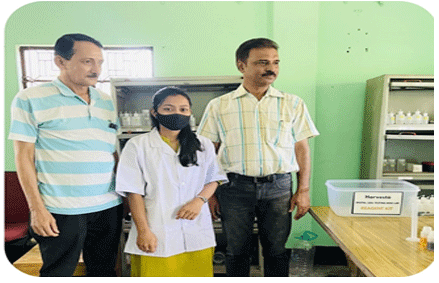Soil Testing
Soil Testing

Centre for Tea Plantation Management,
Golaghat Commerce College
The Soil Testing facility at the College premises has been operating since January 2022, primarily to analyze the soil health of our Tea Plantations
Our Tea Soils have been deteriorating over the years in terms of decreasing nutrition, organic matter content, increasing compactness and acidity, decreasing essential minor and trace elements which are having detrimental effects in terms of yields, quality and increasingmortality of tea bushes.
Furthermore, GlobalClimate Change effects will detoriate further in the years to come and will continue to affect tea plantations adversely and corrective measures in the Soil profile will play a major role in mitigating these adverse effects.
Parameters which can be tested in the Laboratory

1: Organic Carbon
2: Available Nitrogen (Major)
3: Available Phosphorus ( Major)
4: Available Potassium (Major)
5: Available Zinc (Essential)
6: Available Boron (Essential)
7: Available Sulphur (Secondary)
8: Available Iron (Essential)
9: Available Copper (Essential)
10: Available Manganese (Essential)
11: Electrical Conductivity
12: Ph
13: Lime requirements test for Acidic Soils
14: Gypsum requirements test for Alkaline Soils.
Something about the Soil Testing
The deficiencies of nutrient elements and inappropriate nutrient management practices in tea soils is one of the main reasons for low crop yield, quality of the produce and productivity. It is very important to know the deficiencies of Sulphur (S), Zinc(Z), Boron(B), Iron(Fe), Copper (Cu), and Manganese (Mn) and their effective management to achieve sustainable crop production.

Soils are the prime resource of nutrients for plant growth and development. Plants absorb the desired nutrients from soil in different proportions as per their requirements. Phytomicrobes( microbial communities associated with plants) play a pivotal role in enhancing nutrients availability and tea yields.
Besides N(Nitrogen), Phosphorus (P), and Potassium (K), deficiency, deficiencies of Sulphur (S), and micronutrients Zinc(Zn), Boron(B), Iron(Fe), Copper(Cu), and Manganese (Mn), either as a single nutrient deficiency or multi-nutrient deficiencies affect yields of tea plants adversely.
Therefore there is a constant need for continues testing of tea soil samples, and evaluation and monitoring of the extent of micronutrients deficiencies in the Tea Plantations.
Weather factors also affects soil nutrients availability as well as plant nutrients contents by affecting soil moisture, soil biological activities and plant growth. With Global Climate changes these effects have been more enhanced. Deficiencies in any one or more of these micronutrients will reduce both Tea Quality and Tea Yields.
Plants grown in the absence of sufficient quantities of a particular nutrient show visible deficiency symptoms that relate to the function of that nutrient in the plant. Deficiency symptoms can also result from the presence of toxic chemicals, which interferes with the availability or transport of nutrients from the roots. Aluminium is more available in Acidic soils (Tea grows in Acidic soils of ph 4.5 to 5.5 ) and complexes are formed with phosphate creating phosphate deficiencies.
Good Agricultural Practices aims to maintain soil nutrients levels and minimize the availability of toxic compounds. For example liming applications of Calcium or Magnesium oxides, hydroxidesor Carbonates is used to improve Acidic soils and reduce Aluminium toxicity and thereby increasing Phosphate availability.
Some deficiencies and their negative effects:

1: Zinc (Zn):Zinc is a vital element required for the proper growth and development of plants, and its inadequate supply often leads to decrease crop productivity and excellence ( quality of tea produced). A shortage of Zinc can result in drop of effective photosynthesis by 50% to 70%, depending on the crop species as well as the harshness of the deficiency. This results in loss ofcrop in many zinc deficient soils, and has a major affect in the lower return due to yield losses.
2: Boron (B): In general Boron in soil is reported to be in the range of 20 to 200 mg per kg ,and availability varies within the soil. Boron toxicity results from high levels of Boron in the soil. Boron uptake is extremely influenced by soil temperatures. Under drought conditions Boron availability to plants decreases mainly due to low mobility of Boron from soil to roots by mass flow. As Boron is mobile in soil, there are chances to filter down in the soil prophile with surplus moisture. Most of the Boron are present in the surface, or organic layers of the soil , and as and when these layers becomes dry , plants taking Boron from it is limited because of the shortage of water and in such cases plants try to absorb Boron from lower horizons, where organic matter and available Boron are usually low.
3: Manganese (Mn): Manganese is an essential micronutrient for plant growth and development. It is needed in chloroplast formation and photosynthesis, nitrogenmetabolism, and the synthesis of various enzymes.
4: Iron (Fe): Iron is an important constituent of many enzymes linked to Nitrogen fixation and reduction, energy transfer and the formation of Lignin. It has a direct role in the production of Chlorophyll. In Acidic soils enhanced reduction of soil Fe under water logged conditions restricts root growth and reduces the absorptive capacity of the whole root system.
5: Copper (Cu): Copper is an immobile nutrient required for plant growth and development. Copper is an essential constituent of several enzyme systems. It also participates in photosynthesis , cell wall formation, plant metabolism and electron transport.
6: Sulphur (S): The tea crop’s requirement for Sulphur is very high at 16 to 26 kgs per hectare per year. The Sulphur content of flush green tea leaves should be maintained at 0.08% to 0.20% of total dry matter to achieve maximum yields and for processing high Quality teas. 1000 kgs of made tea will thus remove about 10 kgs of Sulphur from the soil per year. Upto 40% of the Sulphur absorbed by the tea roots is recycled into the soil as fallen leaves and pruning litter, but there remains a considerable shortfall. Sulphur is central to plant nutrition. It is needed for the synthesis of Sulphur Containing amino acids and the manufacture of Chlorophyll pigments. Consequences of deficiencies of Sulphur both for yield and quality of tea are severe. Young leaves ( mostly 2 leaf & a bud) are the hardest hit by Sulphur deficiencies. They develop an unhealthy looking pale yellowcolour and a general yellowing of intervenial areas, consequences for yield and quality of teas are severe. Quality of made teas are affected as two leaf and a bud is the main raw material for producing teas, and tea quality is dependent on it’s attributes like flavour, aromas, body, strength, colour and brightness of the liquor.
Colour, brightness, strength, body, taste and flavours of tea liquors are adversely affected by Sulphur deficiencies. The main chemicals namely Theaflavin (TF) and Thearubin (TR) responsible for body, strength, taste, odour, and the bright/yellow colours of a quality cup of liquor were found in higher concentrations following Sulphur applications . There is also a marginal increase in the flavanol glycosides, such as rutinand quercetin and is believed to contribute to a brighter colour and enhanced flavours.

7: EC (Electrical Conductivity): Cations (Ca 2+, K +, Na +, NH4+) and Anions (SO4 2- , Cl – ,NO3 -) forms Salts. This salt dissolves in water and carry Electrical Charges and conducts Electrical currents. Consequently the concentrations of these Cations and Anions determine the Electrical Conductivity of Soils. Greater presence of Cations and Anions means greater Electrical Conductivity, or EC.
Soil EC does not directly affect plant growth, but has been used as an indirect indicator of the amount of nutrients available for plants uptake. EC has been used as a measure of salt concentrations, organic matter, cation-exchange-capacity, soil texture, soil thickness, nutrients-water-holding capacity and drainage conditions.
High EC can serve as an indication of salinity (concentrations of salts in solutions). High salinity (EC greater than 4dS/m) impedes crop growth, as it increases the plants inability to absorb water even when water is present in the soil. Soils with high EC resulting from a higher concentrations of sodium(Na) generally have poor structure and drainage and becomes toxic for plants.
Causes of high EC could be water used in irrigation, weed and pest control, water logging. All water used having EC less than 0.75 dS/m is considered good, beyond which it increases the EC of the soil.
Rain water does not containdissolved salts. But irrigation water and water used for weed and pest control contains dissolved salts. Most tea plantations have been using this kind of underground water for a long time.
These salts builds up around the root zone. They injure plants, reduce yields, and even change soil structures causing long-term damage to the land itself.
Plants take up water but they don’t take up salts in any appreciable quantities. When these salts accumulate over the years it becomes concentrated there. Salts also attracts water and makes it more difficult for plants to take up water from the soil.
8: Soil Ph: Tea plants grows well in Acidic soils within Ph range of 4.5 to 5.5. A tea plant’s root system contains an abundant amount of organic acids like citric acid, malic acid, oxalic acid and pyretic acid.
Soil acidification has threatened the sustainability of tea plantations. The growth of Tea plants is gradually arrested when the soil Ph is greater than 7.0. When soil Ph is lower than 4.0, tea plants growth is inhibited, affecting both the Quality and Quantity of production.
It has been found that the downward movement of H+ and NH4+ contributes to subsurface acidification. Soil acidifications after the planting of tea results from gradual extension from the rhizosphere( soil around roots) to surrounding soils and from the soil surface to deeper soil layers. It is generally believed that soil Ph change is influenced by Fertilization levels, the amount and type of Fertilizers. With high planting densities of tea plants which are greater than 5000 plants per hectare, the rate of Acidification of Tea soils are high and needs Ph correction steps.
9: SOC( SoilOrganic Carbon) :Soil organic carbon (SOC) refers only to the Carbon Component of organic compounds which is called Soil Organic Matter ( SOM).SOM ,(soil organic matter ) is difficult to measure directly. Generally SOC multiplied by 1.72 gives the SOM . Hence Laboratories tend to measure and report SOC, where after SOM is calculated
SOM is composed mainly of Carbon, Hydrogen and Oxygen and has small amounts of other elements such as Nitrogen, Phosphorus, Sulphur, Potassium, Calcium and Magnesium contained in organic residues. It is divided into “ living “ and “ dead” Components, and can range from very recent inputs such as stubble to largely decayed materials that are thousands of years old. About 10% of below ground SOM such as roots, fauna, and microorganisms is “living “
SOM exists as 4-distinct fractions which vary widely in size, turnover time, and composition in the soil.

1: Dissolved Organic Matter
2: Particulate Organic Matter
3: Humus
4: Resistant Organic Matter
Organic matter contributes to nutrients retention and turnover, soilstructures, MOISTURE RETENTION AND AVAILABILITY, degradation of pollutants.
The unsustainable agricultural management practiced in many Agro-Ecosystems , especially Monoculture like Tea-Plantations , extensive use of tillage, chemical inputs degrades the fragile web of community interactions between pests and their natural enemies thus having negative repercussions on SOC stocks..

For more details contact:
Mr. Ranjit Kumar Mazumdar (P.C.)
Phone:+919101571704
Email : ranjitmazumder@rediffmail.com